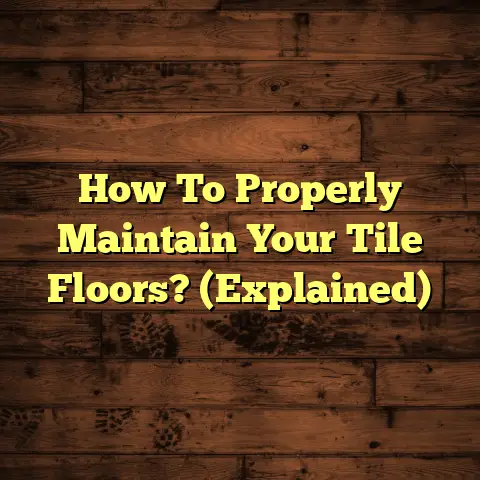Rugs Sliding? (4 Tile Floor Solutions!)
The common misconception is that rugs on tile always slide. That it’s just a fact of life. You might even think there’s nothing you can do about it.
But that’s simply not true!
I’m here to tell you that with the right know-how, you can tame those slippery rugs. No more near-falls, no more constantly adjusting them. Let’s dive into some solutions that’ll keep your rugs exactly where you want them.
Section 1: Understanding the Problem of Sliding Rugs on Tile Floors
Why do rugs slide on tile anyway? It’s a perfect storm of factors.
First, tile surfaces are smooth. Really smooth. That polished surface offers very little grip. Imagine trying to run on an ice rink – same principle!
Then there’s the rug itself. Lightweight rugs, especially those with smooth backings, are the biggest offenders. Think about a thin cotton rug versus a thick wool one. Which one is more likely to stay put?
The material of the rug also matters. Some materials, like certain synthetic fibers, are inherently more slippery than natural fibers like wool or jute.
And let’s not forget the backing! A rug with a hard, slick backing is practically begging to slide across your tile.
The interaction between the rug and the tile is key. It all comes down to friction – or the lack thereof. The smoother the surfaces, the less friction, and the more likely your rug is to go for a little trip.
Think about the conditions in your home. Is it a high-traffic area? Do kids or pets run through the room frequently? The more movement, the more likely your rug is to slide.
I once had a client with a beautiful, but incredibly slippery, silk rug in their entryway. Every time someone came in, the rug would inch further and further away from the door. It was a constant battle!
Recognizing these factors is the first step to fixing the problem. Now, let’s get to the solutions!
Section 2: Solution 1 – Non-Slip Rug Pads
Non-slip rug pads are your first line of defense. Think of them as the unsung heroes of the rug world. They create a barrier between the rug and the tile, adding much-needed grip.
There are several types of non-slip pads available:
-
Rubber Rug Pads: These are usually made of natural or synthetic rubber. They provide excellent grip and are a great choice for most rugs on tile. They’re durable and tend to last a long time.
-
Felt Rug Pads: These offer cushioning and protect your tile from scratches, but may not provide as much grip as rubber pads. Some felt pads have a rubber backing for added slip resistance.
-
Dual-Sided Rug Pads: These have a different material on each side – one for grip against the rug, and another for grip against the tile. They’re a good all-around option.
Choosing the Right Rug Pad:
-
Thickness: Consider the thickness of the pad. A thicker pad provides more cushioning, but it can also raise the rug’s height, potentially creating a tripping hazard. I usually recommend a thickness of around 1/4 to 1/2 inch for most situations.
-
Size: The rug pad should be slightly smaller than the rug itself. This prevents the pad from peeking out from under the rug. Aim for a pad that’s about 1-2 inches smaller on all sides.
-
Material Compatibility: Make sure the pad material is compatible with your tile. Some rubber pads can stain certain types of tile, so it’s always a good idea to test a small, inconspicuous area first.
Installing a Rug Pad:
-
Clean the Tile: Make sure the tile surface is clean and dry. Any dirt or debris can reduce the pad’s effectiveness.
-
Position the Pad: Place the rug pad on the tile where you want the rug to be.
-
Place the Rug: Carefully position the rug on top of the pad.
Maintenance Tips:
-
Vacuum Regularly: Vacuum the rug pad along with the rug to remove any dirt or debris that may have accumulated.
-
Rotate the Pad: Every few months, rotate the rug pad to distribute wear and tear evenly.
-
Replace as Needed: Over time, rug pads can lose their grip. Replace them when they start to lose their effectiveness.
I’ve found that a good quality rubber rug pad can make a world of difference. It’s a simple, effective, and relatively inexpensive solution to the sliding rug problem.
Section 3: Adhesive Solutions
Sometimes, a rug pad just isn’t enough. For smaller rugs, or rugs in high-traffic areas, you might need to bring in the big guns: adhesive solutions.
Here are a few options:
-
Double-Sided Tape: This is a classic solution. Look for tape specifically designed for rugs, as it will have a stronger adhesive that won’t damage your tile or rug.
-
Rug Grippers: These are small, adhesive pads that you attach to the corners and edges of your rug. They’re a good option for smaller rugs that tend to slip in specific areas.
When and Where to Use Adhesive Solutions:
-
High-Traffic Areas: Adhesive solutions are great for rugs in entryways, hallways, or other areas where people walk frequently.
-
Smaller Rugs: Smaller rugs are more prone to sliding, so adhesive solutions can provide extra security.
-
Rugs on Smooth Tile: If you have very smooth, polished tile, adhesive solutions can help to create a stronger bond.
Applying Adhesive Solutions:
-
Clean the Surfaces: Make sure both the tile and the rug backing are clean and dry.
-
Apply the Adhesive: For double-sided tape, apply strips of tape to the corners and edges of the rug backing. For rug grippers, peel off the backing and attach them to the corners and edges.
-
Press Firmly: Press the rug firmly onto the tile to create a strong bond.
Potential Drawbacks:
-
Residue: Some adhesive solutions can leave residue on the tile or rug backing. Choose a product that’s specifically designed for rugs and tile to minimize this risk.
-
Damage: If you’re not careful, you can damage the tile or rug when removing the adhesive. Always follow the manufacturer’s instructions carefully.
Mitigating the Drawbacks:
-
Test First: Before applying adhesive to the entire rug, test a small, inconspicuous area first to make sure it doesn’t damage the tile or rug.
-
Use a Residue Remover: If you do end up with residue, use a residue remover specifically designed for adhesive.
-
Be Gentle: When removing the adhesive, be gentle and avoid pulling too hard.
I once used double-sided tape to secure a small rug in front of a client’s kitchen sink. It was a high-traffic area and the rug was constantly sliding around. The tape worked like a charm, and the client was thrilled to finally have a rug that stayed put.
Section 4: Weight and Design Considerations
Believe it or not, the weight and design of your rug can play a big role in its stability.
A heavier rug is naturally going to stay in place better than a lightweight one. Think about it – it takes more force to move something that’s heavy.
Rugs with a non-slip backing are also a good choice. These rugs have a special backing material that’s designed to grip the tile surface.
Examples of Rug Materials and Weaves:
-
Wool Rugs: Wool rugs are generally heavier than synthetic rugs and have a natural grip.
-
Jute Rugs: Jute rugs have a rough texture that provides good traction.
-
Rugs with a Dense Weave: Rugs with a dense weave are heavier and less likely to slide than rugs with a loose weave.
Designing a Room Layout:
-
Use Furniture to Anchor Rugs: Place heavy furniture, such as sofas or chairs, on the edges of the rug to help hold it in place.
-
Layer Rugs: Layering a smaller rug on top of a larger rug can help to prevent the smaller rug from sliding.
-
Create a Focal Point: Position the rug in a way that draws attention to a specific area of the room, such as a fireplace or a seating area.
I had a client who was struggling to keep a lightweight rug in place in their living room. I suggested they replace it with a heavier wool rug and place the front legs of their sofa on the edge of the rug. The change made a huge difference, and the rug stayed put perfectly.
Section 5: DIY and Home Remedies
Okay, let’s get crafty! If you’re on a budget, or just like a good DIY project, there are plenty of home remedies you can try to keep your rugs from sliding.
-
Silicone Caulk: Apply thin beads of silicone caulk to the underside of the rug, creating a grid pattern. Let the caulk dry completely before placing the rug on the tile. The silicone will create a non-slip surface.
-
Rubberized Paint: Paint the underside of the rug with rubberized paint. This will create a textured surface that grips the tile.
-
Velcro Strips: Attach Velcro strips to the corners and edges of the rug, and then attach the corresponding strips to the tile. This will create a secure bond that can be easily removed when you need to clean the rug.
-
Custom Rug Weights: Create custom rug weights by filling small bags with sand or gravel and attaching them to the corners of the rug.
Thinking Outside the Box:
-
Use Shelf Liner: Cut pieces of non-slip shelf liner to fit under the corners of the rug.
-
Try Hot Glue: Apply small dots of hot glue to the underside of the rug.
-
Experiment with Different Materials: Don’t be afraid to try different materials you may already have at home.
Important Note: Always test any DIY solution on a small, inconspicuous area of the rug and tile first to make sure it doesn’t cause any damage.
I once helped a friend who was struggling to keep a small rug from sliding in her bathroom. We ended up using silicone caulk to create a non-slip surface on the underside of the rug. It was a cheap and easy solution, and it worked perfectly!
Conclusion: Emphasizing the Importance of a Secure Rug
So, there you have it! Four solutions to conquer the dreaded sliding rug.
Remember, a secure rug isn’t just about aesthetics. It’s about safety. A sliding rug can be a tripping hazard, especially for kids and the elderly.
It’s also about protecting your floors. A sliding rug can scratch or damage your tile over time.
And it’s about peace of mind. No more constantly adjusting your rug or worrying about someone falling.
Don’t let the myth of the inevitable sliding rug hold you back. Take action! Try one of these solutions and enjoy the benefits of a secure, beautiful, and safe home.
You got this!





